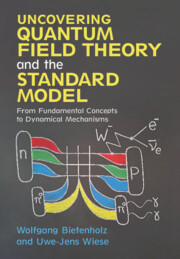Refine search
Actions for selected content:
4 results
9 - Particles in a Magnetic Field
-
- Book:
- Quantum Mechanics
- Published online:
- 27 June 2025
- Print publication:
- 19 June 2025, pp 278-310
-
- Chapter
- Export citation

Uncovering Quantum Field Theory and the Standard Model
- From Fundamental Concepts to Dynamical Mechanisms
-
- Published online:
- 06 February 2025
- Print publication:
- 02 January 2025
-
- Textbook
- Export citation
Ouverture: Concepts of Quantum Field Theory
- from Part I - Quantum Field Theory
-
- Book:
- Uncovering Quantum Field Theory and the Standard Model
- Published online:
- 06 February 2025
- Print publication:
- 02 January 2025, pp 3-9
-
- Chapter
- Export citation
10 - Gauge fields and strain engineering
-
- Book:
- The Physics of Graphene
- Published online:
- 24 May 2020
- Print publication:
- 19 March 2020, pp 257-278
-
- Chapter
- Export citation
